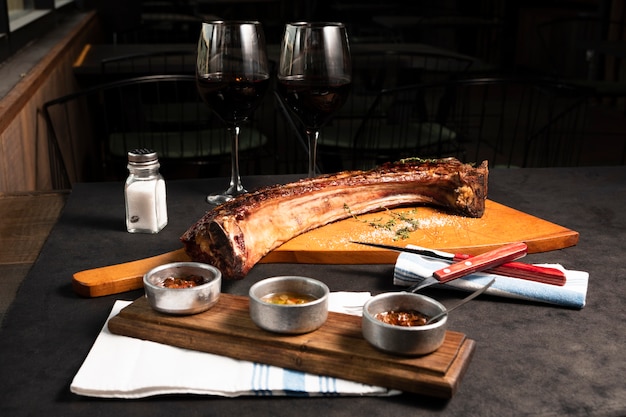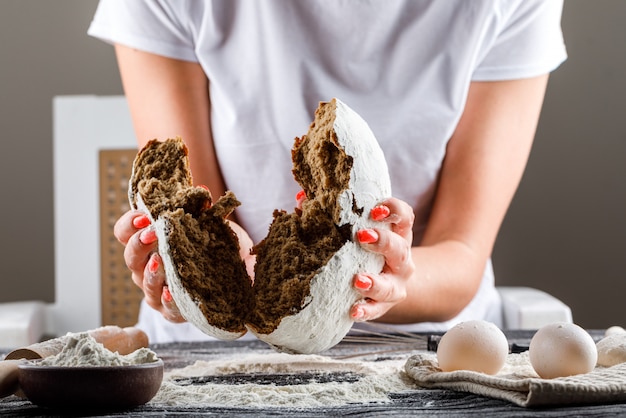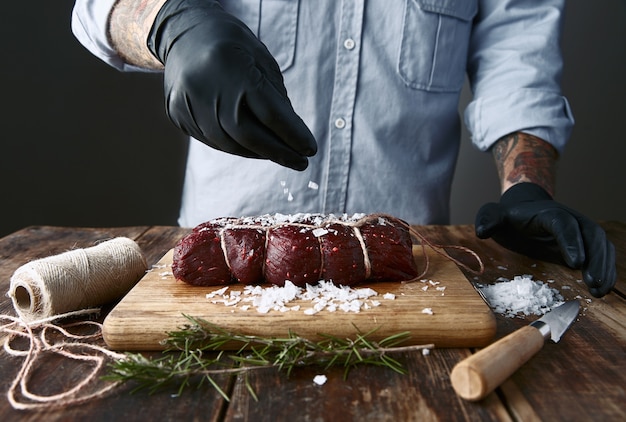(Part 1) Choosing the Right Ribs: A Foundation for Flavor

Navigating the Cuts: A Guide to Spare Ribs
The first step on our rib-cooking journey is picking the perfect raw material. There are a few different types of ribs available, but for today's adventure, we're focused on the most common and versatile: spare ribs. These bad boys come from the lower part of the rib cage and are known for their meaty, marbled goodness. This marbling, the streaks of fat throughout the meat, gives them that rich, succulent flavour we all crave. They've got a fantastic balance of meat and fat, which translates into juiciness and tenderness when cooked correctly.The Importance of Freshness: A Key to Success
Now, let's talk about freshness. When choosing your ribs, freshness is key. Look for a bright red colour, a slight firmness to the touch, and a pleasant aroma. If the ribs are too pale, feel slimy, or have an off-putting smell, it's a sign they've been sitting around too long. Avoid those like the plague!I always recommend chatting with your butcher about the ribs. They're a wealth of knowledge and can give you tips on selecting the best ones. Don't be shy – ask them about their experience and what they recommend. You'll be glad you did!(Part 2) Prepping for Perfection: A Few Simple Steps

Removing the Membrane: Unlocking Flavor and Tenderness
Once you've got your ribs home, it's time to give them a little TLC before cooking. The first thing you'll want to do is remove the membrane. This is a thin, white, slightly tough layer of skin that runs along the back of the ribs. It might seem like a small detail, but removing it makes a huge difference.You can easily remove the membrane using a sharp knife or a pair of kitchen shears. Just slip the blade under the membrane and gently pull it off. It may take a little effort, but it's worth it! Removing the membrane allows your seasoning and sauce to penetrate deeper into the ribs, enhancing flavour and making them more tender. It also helps prevent the ribs from shrinking too much during cooking, ensuring a more generous portion of meaty goodness.Seasoning Your Ribs: A Symphony of Flavors
Now, here's where you can really let your culinary creativity shine! Spare ribs are incredibly versatile and readily embrace a wide range of flavour profiles. There are no hard and fast rules here, just a canvas for your imagination.Here are a few of my go-to seasoning blends that will turn your ribs into flavour-packed stars: Classic dry rub: A timeless combination of salt, pepper, paprika, garlic powder, onion powder, and a touch of cayenne pepper. This blend delivers a balanced flavour that's both savoury and slightly spicy. Sweet and Smoky: For those who love a touch of sweetness and a hint of smoke, this mix is a winner. Combine brown sugar, smoked paprika, chili powder, cumin, and a little bit of mustard powder. The result is a rich, flavourful crust that's irresistible. Herbaceous Delight: If you prefer a fresh, herbaceous flavour, this blend is for you. Combine fresh herbs like rosemary, thyme, oregano, and parsley with garlic powder, onion powder, and salt. The aroma alone will tantalize your senses!Feel free to experiment and create your own unique blend. You can add other spices, like smoked salt, smoked pepper, or even a little bit of dried thyme. Remember, the beauty of cooking is that there is no right or wrong, only endless possibilities.(Part 3) Low and Slow: Unveiling the Secrets to Tenderness

The Art of Smoking: A Symphony of Flavor and Texture
For those who seek the pinnacle of rib-cooking perfection, smoking is the ultimate method. It's a slow, gentle process that allows the ribs to break down and become incredibly tender. The smoke infuses the ribs with a depth of flavour that's simply unmatched.Here's a glimpse into the world of smoking ribs: Choosing Your Wood: A Flavorful Journey: Different woods impart distinct flavours, so selecting the right wood is a crucial step. For a classic smoky flavour, go with hickory or mesquite. If you prefer a milder flavour, opt for applewood or cherrywood. Each wood offers a unique aroma and taste that can transform your ribs. Low and Slow is the Mantra: Patience is key when smoking ribs. The sweet spot for temperature is between 225°F and 250°F (107°C and 121°C). This low and slow cooking method ensures even cooking and allows the collagen in the ribs to break down, resulting in melt-in-your-mouth tenderness. Embrace the Process: Smoking ribs takes time, often 4-6 hours depending on their size. But trust me, the wait is worth it. The result is a symphony of textures and flavours that will leave you utterly satisfied. The meat thermometer: Your Culinary Compass: To ensure your ribs are cooked through, use a meat thermometer to check their internal temperature. They should reach 190°F (88°C) for the most tender results. This will ensure that the ribs are cooked through and safe to eat.Grilling: A Quick and Satisfying Alternative
Not everyone has a smoker, or the time for a lengthy cooking process. If that's the case, grilling is a great alternative, offering a quick and delicious solution.Here's how to achieve mouthwatering grilled ribs: Prep Your Grill: Preheat your grill to medium-high heat (around 350°F - 400°F). You want to create a good sear that will lock in the juices and flavour. Two-Stage Cooking: For Maximum Flavor: Start by grilling the ribs for about 10 minutes per side to achieve a nice char. Then, reduce the heat to low and continue cooking for about 2-3 hours, with the lid closed, until the ribs are tender. This two-stage process ensures that the ribs are cooked evenly and develop a delicious smoky flavour. The Power of the Grill Pan: If you don't have a gas grill, no worries! You can use a grill pan on the stovetop to achieve a similar char and flavour. Just make sure your pan is nice and hot before adding the ribs.(Part 4) The Sauce: Adding the Finishing Touches
Applying the Sauce: A Balancing Act
With your ribs cooked to perfection, it's time to add the grand finale: the sauce. Remember, less is more when it comes to sauce. You don't want to drown the ribs, just glaze them with a beautiful, sticky coating that enhances the flavour without overpowering it.Here's my approach to sauce application: The Art of Glaze: I like to apply a thin layer of sauce about 30 minutes before the ribs are finished cooking. Then, I give them another coat during the last 15 minutes. This allows the sauce to caramelize and create that irresistible, glossy glaze. Basting for Maximum Flavor: While the ribs are cooking, I baste them with sauce every 30 minutes. This keeps them moist and helps the sauce penetrate deeper, creating a symphony of flavour throughout the meat.Choosing the Right Sauce: A Flavour Odyssey
The best rib sauce is truly a matter of personal preference. Do you crave a sweet and smoky flavour? A tangy and spicy kick? Or a classic barbecue sauce with just a hint of sweetness? The world of rib sauces is your oyster!Here are a few sauce styles to consider: Sweet and Smoky: These sauces often use brown sugar, molasses, and smoked paprika to create a rich and flavourful glaze. The sweetness balances the smokiness beautifully, creating a harmonious flavour profile. Spicy and Tangy: Think of sauces that use vinegar, chili powder, and cayenne pepper to add a good amount of heat. These sauces pack a punch with their tangy, spicy notes, perfect for those who enjoy a bit of fire. Classic Barbecue: These sauces are typically a balance of sweet, smoky, and savoury flavours, with a thick and rich consistency. They offer a familiar, comforting flavour that's always a crowd-pleaser.Don't be afraid to experiment with different sauces and create your own blends. The possibilities are endless!(Part 5) Serving Time: Presenting Your Culinary Masterpiece
Resting and Carving: Unlocking Tenderness and Flavor
Once your ribs are cooked, let them rest for at least 15 minutes. This allows the juices to redistribute throughout the meat, making them even more tender and juicy. It's a crucial step that will elevate your ribs to a new level of deliciousness.After the resting period, it's time to carve those ribs! You can either cut them into individual ribs or leave them as a whole rack. If you're serving them to a crowd, cutting them into individual ribs makes it easier for everyone to enjoy.Perfecting the Sides: A Symphony of Flavors
No rib feast is complete without a delicious selection of sides. Here are a few of my favourites that complement the rich, smoky flavour of ribs perfectly: potato salad: A classic side dish that's creamy, tangy, and satisfying. It's the perfect counterpoint to the rich flavour of the ribs. Coleslaw: A refreshing and tangy salad that adds a bright, crunchy element to the meal. It balances the heaviness of the ribs beautifully. Cornbread: A sweet and buttery bread that goes great with barbecue sauce. It's the perfect vehicle for soaking up all those delicious juices. Mac and Cheese: A rich and cheesy comfort food that's always a crowd-pleaser. It's a perfect addition to any rib feast.Remember, the possibilities are endless! Experiment with different side dishes to create a meal that's truly your own.(Part 6) Beyond the Basics: Exploring Different Techniques
The Magic of Slow Cooking: Effortless Tenderness
If you're looking for a hands-off approach to cooking ribs, slow cooking is your best friend. Simply place the ribs in your slow cooker, cover them with sauce, and cook on low for 6-8 hours. The slow, gentle heat will break down the connective tissues, creating incredibly tender ribs that practically melt in your mouth.Oven Baking: A Simple Weeknight Solution
Sometimes, you just want a quick and easy way to cook ribs without the fuss of grilling or smoking. Oven baking is a perfect solution for those busy weeknights. Place the ribs on a baking sheet, cover them with sauce, and bake at 325°F for 2-3 hours. The result? Delicious and tender ribs without any complicated steps.(Part 7) Tips and Tricks: Mastering the Art of rib cooking
Troubleshooting Common Issues: Navigating Culinary Challenges
We've all been there: you put your heart and soul into cooking ribs, and something just doesn't seem quite right. Don't worry, I've got you covered. Here are a few common rib cooking issues and how to fix them: Dry Ribs: If your ribs are dry, it's likely they were cooked for too long or at too high a temperature. To prevent this, cook the ribs at a lower temperature and use a meat thermometer to check the internal temperature. Also, remember to baste the ribs regularly to keep them moist. Tough Ribs: If your ribs are tough, they may not have been cooked long enough. Make sure to cook the ribs until they reach an internal temperature of at least 190°F. You can also use a slow cooking method to break down the tough connective tissues. Unevenly Cooked Ribs: If your ribs are unevenly cooked, the heat may not have been distributed evenly. Make sure to cook the ribs on a stable and even heat source. Also, rotate the ribs halfway through the cooking process to ensure they cook evenly on all sides.Saving Leftovers: Making the Most of Your Rib Feast
Got more ribs than you can handle? No problem! You can easily store leftover ribs in the fridge for up to 3 days. Simply place them in an airtight container and refrigerate. When you're ready to enjoy them again, reheat them in the oven or microwave.(Part 8) FAQs: Addressing Common Questions
Q1: How do I tell if ribs are done?
The best way to tell if your ribs are done is to use a meat thermometer. They should reach an internal temperature of at least 190°F (88°C). You can also check for tenderness by gently tugging on the ribs. If they come off the bone easily, they're ready to eat.Q2: What kind of smoker should I use?
There are many different types of smokers available, from traditional offset smokers to electric smokers. The best smoker for you will depend on your budget and your level of experience. If you're just starting out, an electric smoker can be a great option. However, if you're more experienced and have a bit more budget, a traditional offset smoker will give you a more authentic smoky flavour.Q3: What if I don't have a smoker or grill?
If you don't have a smoker or grill, you can still make delicious ribs in the oven. Simply place the ribs on a baking sheet, cover them with sauce, and bake at 325°F for 2-3 hours. The result? Delicious and tender ribs without the fuss.Q4: How do I make my ribs fall off the bone?
The key to making ribs fall off the bone is to cook them slowly and at a low temperature. This will allow the collagen in the ribs to break down, creating incredibly tender meat. You can also use a slow cooking method, like a slow cooker or oven baking, to achieve this result.Q5: What are some good ways to serve ribs?
Ribs are incredibly versatile and can be served in many different ways. You can serve them as a main course, or as an appetizer. They're also delicious served with a side of potato salad, coleslaw, cornbread, or mac and cheese. Get creative and experiment with different side dishes to find your favourites.Conclusion: Embracing the Joy of Rib Cooking
Making ribs that fall off the bone and burst with flavour is a rewarding experience. It's a culinary journey that takes you from the butcher's counter to your own table, a symphony of flavours and textures that will leave you satisfied. I hope this guide has given you all the tools you need to make your own delicious ribs. Remember, it's all about finding what works best for you and your taste buds. So, go out there, embrace the adventure, and experiment with different techniques and flavours. And remember, if you ever need a little inspiration, just reach out and ask. I'm always happy to share my rib-making knowledge and help you create a culinary masterpiece. Happy cooking!Everyone is watching

Corn on the Cob: The Ultimate Guide to Perfectly Cooked Ears
Healthy MealsAh, corn on the cob. Just the name evokes images of sunny days, barbecues, and that sweet, juicy flavour that ...

Perfect Pork Roast Oven Cooking Time: A Guide to Delicious Results
Healthy MealsThere's something truly satisfying about a perfectly roasted pork. The aroma alone is enough to make your mout...

Ham Cooking Time: How Long to Bake, Smoke, or Boil a Delicious Ham
Healthy MealsAh, ham. It's a classic, isn't it? A real crowd-pleaser, especially around holidays. And when done right, it'...

Scallops: The Ultimate Guide to Perfect Cooking
Healthy MealsAh, scallops. Those delicate, sweet, and utterly delicious morsels of the sea. They hold a special place in my...

Spaghetti Squash: The Ultimate Guide to Cooking and Serving
Healthy MealsRemember that time you saw spaghetti squash at the supermarket, looking all bumpy and strange, and thought, "W...
